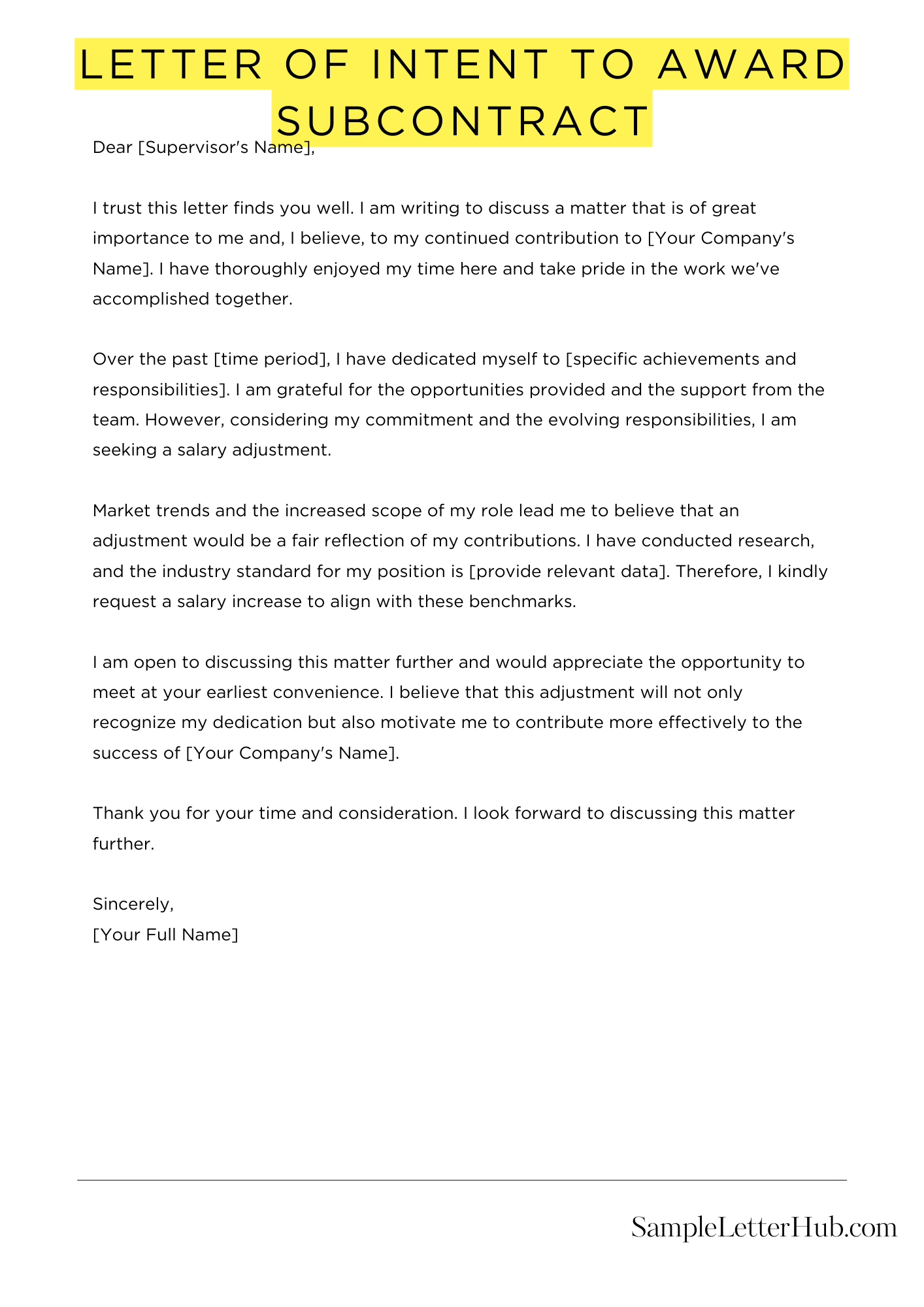A letter of intent to award a subcontract is a document that a prime contractor sends to a subcontractor to indicate its intent to award a subcontract to that subcontractor. The letter of intent is not a binding contract, but it does give the subcontractor a reasonable expectation that it will be awarded the subcontract.
In this article, we will share several templates, examples, and samples of letters of intent to award subcontracts. These templates and samples will help you to draft your own letter of intent to award a subcontract.
Letter of Intent to Award Subcontract
Dear [Recipient Name],
We are pleased to inform you that we intend to award a subcontract to [Recipient Company Name] for the [Subcontract Description] portion of the [Project Name] project.
This letter of intent is not a binding contract, but it serves as our formal expression of intent to award the subcontract to your company. The final subcontract agreement will be subject to negotiation and execution by both parties.
We have selected your company for this subcontract based on your experience, qualifications, and competitive pricing. We believe that your team has the expertise and resources necessary to successfully complete this project.
The scope of work for the subcontract will include:
* [List of tasks and responsibilities]
The estimated value of the subcontract is [Amount]. The subcontract period is expected to commence on [Start Date] and conclude on [End Date].
We would like to schedule a meeting with you to discuss the subcontract further and finalize the details. Please contact us at [Your Phone Number] or [Your Email Address] to arrange a time.
Thank you for your interest in this project. We look forward to working with you as we move forward.
Sincerely,
[Your Name]

How to Write a Letter of Intent to Award Subcontract
1. Introduction
A letter of intent to award subcontract is a document that expresses the intent of a prime contractor to award a subcontract to a specific subcontractor. This letter is typically used in the construction industry, but it can also be used in other industries as well.
2. Purpose of a Letter of Intent
The purpose of a letter of intent is to provide the subcontractor with a formal notice that they have been selected for the subcontract. This letter also outlines the terms and conditions of the subcontract, including the scope of work, the price, and the payment schedule.
3. Contents of a Letter of Intent
A letter of intent should typically include the following information:
* The name and address of the prime contractor
* The name and address of the subcontractor
* The date of the letter
* A statement of intent to award the subcontract
* The scope of work
* The price
* The payment schedule
* Any other relevant terms and conditions
4. Legal Considerations
A letter of intent is not a legally binding contract. However, it is important to note that a letter of intent may create a binding obligation if it contains certain elements, such as an offer, acceptance, and consideration. Therefore, it is important to carefully review the letter of intent before signing it.
5. Drafting a Letter of Intent
When drafting a letter of intent, it is important to use clear and concise language. The letter should be easy to understand and should not contain any ambiguous language. It is also important to make sure that the letter is complete and that it includes all of the necessary information.
6. Negotiating the Terms of the Subcontract
Once the letter of intent has been signed, the prime contractor and the subcontractor will need to negotiate the terms of the subcontract. This negotiation process can be complex, and it is important to have an attorney review the subcontract before signing it.
FAQs about Letter Of Intent To Award Subcontract
What is a Letter of Intent to Award Subcontract?
A Letter of Intent to Award Subcontract (LOI) is a non-binding agreement that indicates a company’s intention to award a subcontract to a specific vendor. It outlines the scope of work, the subcontract price, and the proposed timeline for the project.
When is a LOI typically used?
An LOI is typically used when a company wants to secure a vendor’s commitment to perform the subcontract work before finalizing the subcontract agreement. It allows both parties to express their understanding of the project and to establish a timeline for completing the subcontract.
What are the key elements of a LOI?
The key elements of an LOI include the names of the parties involved, the scope of work, the subcontract price, the proposed timeline, and any other relevant terms and conditions.
Is a LOI legally binding?
No, a LOI is not legally binding. It is a non-binding agreement that expresses the parties’ intentions to enter into a subcontract agreement. However, it can be used as evidence of the parties’ understanding of the project and their commitment to perform the work.
What happens after a LOI is signed?
After a LOI is signed, the parties will typically negotiate and finalize the subcontract agreement. The subcontract agreement will be a legally binding document that outlines the terms and conditions of the subcontract.

